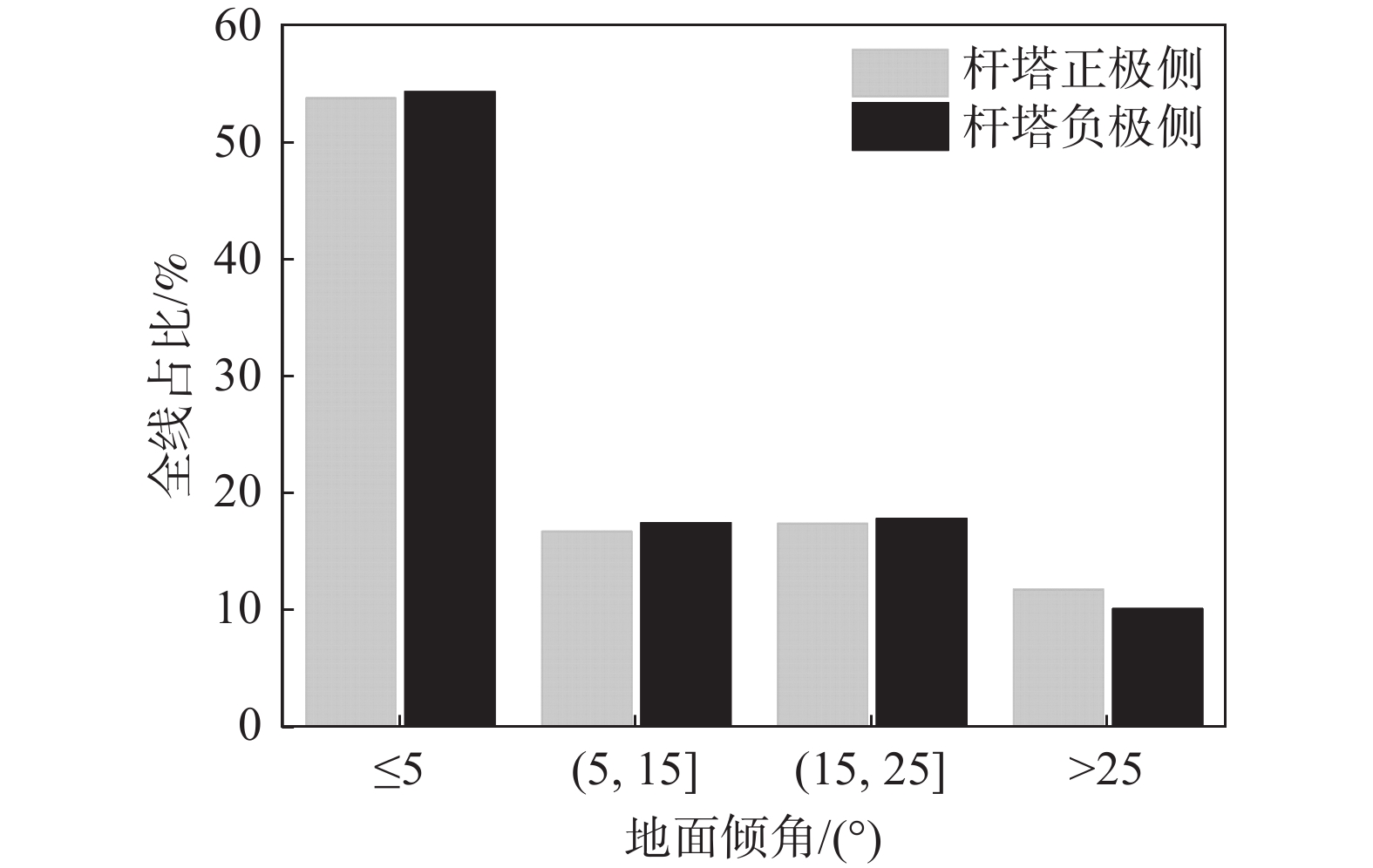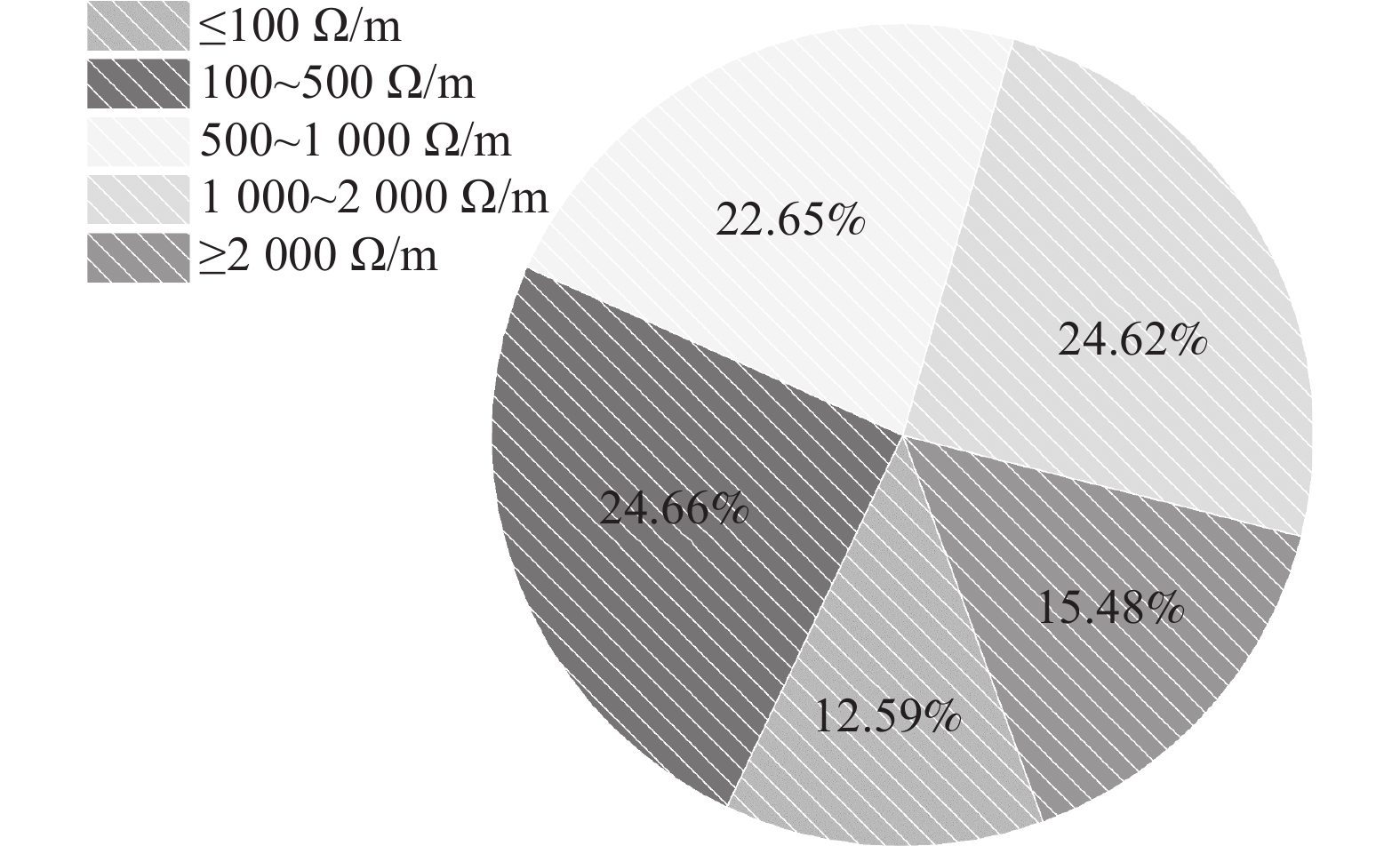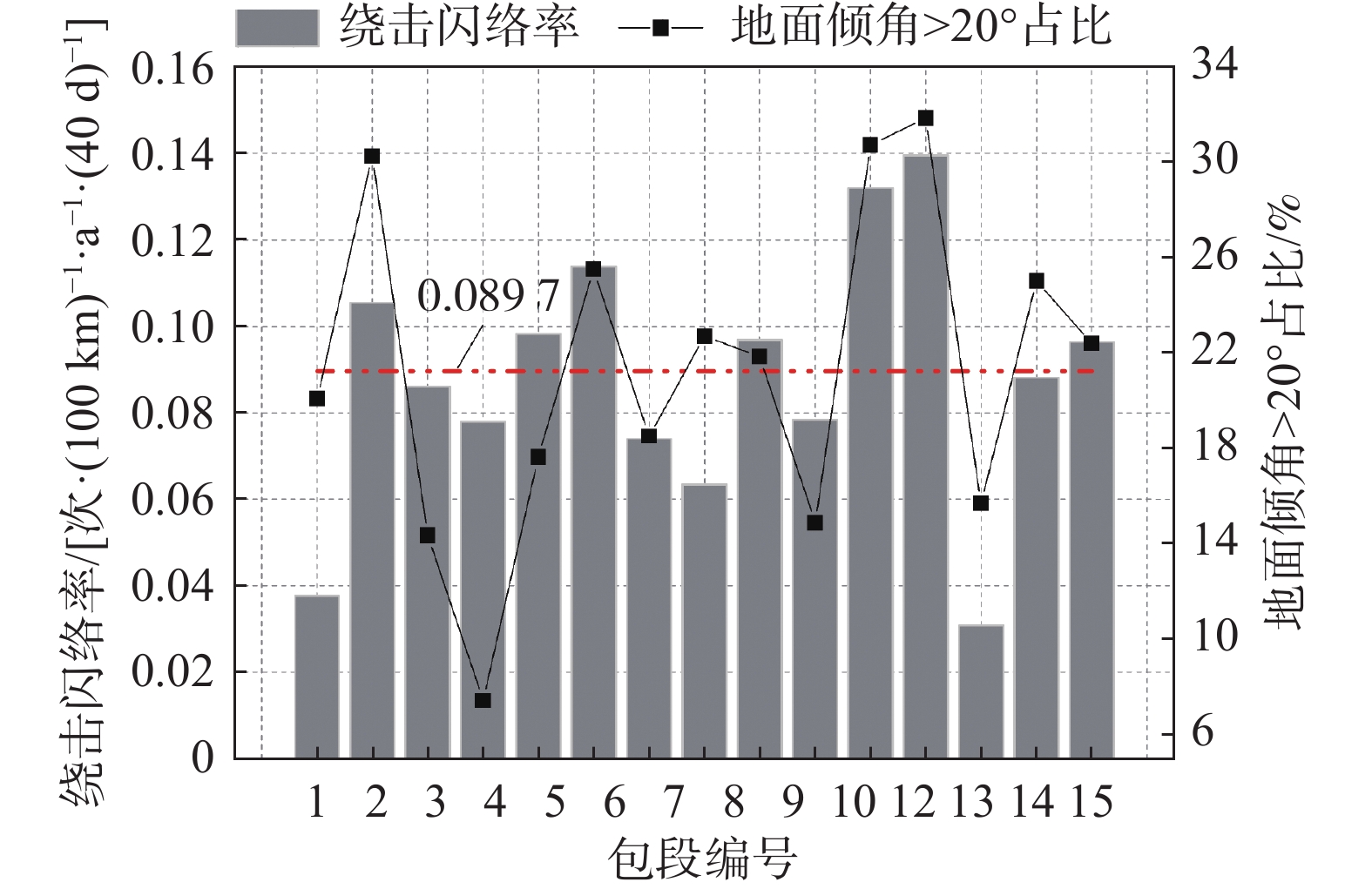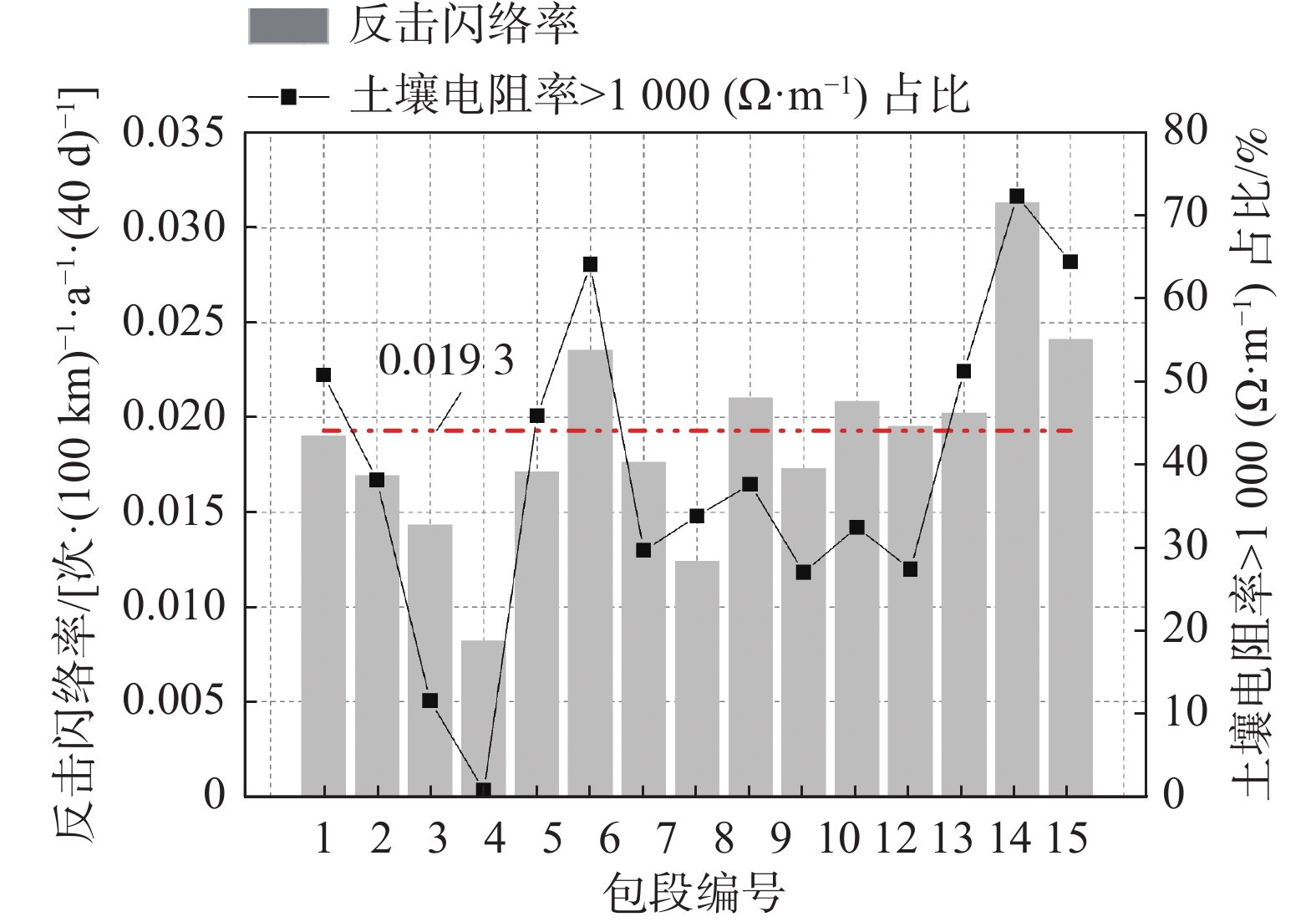-
±800 kV特高压直流输电线路作为直流输电系统的重要组成部分,其安全与稳定性尤为重要[1],据相关资料显示,截至2017年12月底,±800 kV复奉线、±800 kV锦苏线、±800 kV宾金线共发生各类重启28次。其中,雷击导致重启19次,占所有重启事故的67.9%,是造成“三大直流”线路重启的首要原因[2]。
输电线路电压等级,杆塔设计、导线参数、地形与地质条件等都会对特高压直流线路的雷电性能造成影响[3-5]。国内外对于输电线路的绕击耐雷性能分析方法[6]主要涵盖规程法、经典与改进的电气几何模型(EGM)法、先导发展模型(LPM)法。其中规程法[7]基于运行经验及小电流下的模型试验结果提出,工程应用较为简单,但对于超(特)高压等级线路,该方法与实际运行情况的差别较大;先导发展模型[8]基于长空气间隙放电与雷电放电过程的相似性,较为清晰地描述了雷电绕击发展的物理内涵,但针对先导起始、击穿判据、上下行先导发展规律目前仍存在不同的观点,且尚无运行经验验证。改进的电气几何模型法[9]在经典几何模型基础上考虑了构筑物结构高度对引雷效果的影响,应用简便,且和实际运行经验相比较为相符,该方法在日本、欧美等国家得到了广泛运用,在我国也得到了普遍认可,因此,本文采用EGM法计算线路的雷电绕击性能。对于雷电反击的分析方法,目前主要包括规程法、行波法、蒙特卡洛法以及电磁暂态程序法(EMTP)[10]。其中EMTP法在相关科研及设计单位应用较为广泛,目前使用较多的仿真软件有“ATP-EMTP”和“PSCAD-EMTDC”等,在电力系统雷电过电压的数值分析领域提供了有效手段[11-13],本文采用该方法并结合杆塔的多波阻抗模型分析输电线路的雷电反击性能,计算时考虑了波在传播过程中的畸变、折反射、绝缘子串击穿的物理过程以及杆塔结构对波传播过程的影响等因素。
特高压直流线路工程沿线走廊雷电活动、海拔、气象、地形与地质条件等因素分布复杂,在工程建设前期开展防雷专项评估、提出必要的保护优化措施是确保工程安全稳定运行的关键,本文依托我国某在建±800 kV直流线路工程,开展线路耐雷性能、防雷保护措施等方面的分析研究,为今后特高压直流输电线路的防雷设计及运行提供技术参考。
-
通常将地区的雷电活动频繁程度用年平均雷暴日(Thunderstorm days,Td)或地闪密度(Ground flash density,Ng)表示。地闪密度与雷暴日之间的换算关系可由式(1)确定。
$$ N_{\rm{g}} = {0.023}{T_{\rm{d}}}^{{1.3}} $$ (1) 根据年平均雷暴日数或地闪参数将雷区划分为4个层级,分别为少雷区(Td<15,Ng≤0.78)、中雷区(15≤Td<40,0.78<Ng≤2.78)、多雷区(40≤Td<90,2.78<Ng≤7.98)与强雷区(90≤Td,7.98<Ng)。由气象台站雷暴日统计数据,沿线雷暴日数的分布比例如表1所示,全线加权平均雷暴日数为47.2 d。
雷暴日/d 线路长度/km 所占比例/% 40 1 165.8 55.39 50 676.6 32.14 70 211.1 10.03 80 51.4 2.44 Table 1. Statistics of thunderstorm days along the line
-
导、地线型根据工程实际设计条件选用,基本计算参数如表2所示。
类型 导线型号 直流电阻/[Ω·(km)−1] 外径/mm 计算弧垂/m 悬挂高度/m 极导线 JL1/G3A-1000/45 0.028 9 42.1 20.18 54~75 JL1/G2A-1000/80 0.028 6 42.9 9.77~22.34 54~75 JL1/G2A-900/75 0.034 5 40.6 15.57~17.1 54~75 JLHA4/G2A-900/75 0.034 5 40.6 16.71~26.38 54~75 JLHA1/G2A-900/75 0.037 4 40.6 12.93 54~75 普通地线 JLB20A-150 0.581 15.8 5.85~17.55 60~81 JLB20A-240 0.358 20.0 11.9~15.01 60~81 JLB20A-300 0.420 11.5 7.26 60~81 Table 2. Calculating parameters for pole conductor and ground wire
基于沿线不同海拔及组合气象区所采用的塔型数量,各选取一基主力杆塔如表3所示。以ZC27102A典型杆塔为例,其极导线布置情况、塔头尺寸等计算参数如图1(a)所示。
地形 冰区/mm 海拔/m 主力塔型 带电体对塔身构件
最小间隙距离/m平丘 10 0~1 500 Z27102A 6.74 山地 10 0~1 500 ZC27102A 6.74 10 1 500~2 000 ZC30102A 7.05 15 0~2 000 ZC27153A 7.11 15 2 000~3 000 ZC30151B 8.43 20 500~1 500 ZC27204A 8.10 20 1 500~3 000 ZC30203B 10.10 30 1 000~2 000 ZC27302B 10.02 30 2 000~3 500 ZC30301B 9.79 40 1 000~2 500 ZC27401B 8.41 60 2 000~3 000 ZC3060B 7.70 Table 3. Typical towers selected for different terrains, altitudes and ice zone
杆塔采用多波阻抗模型[14],对横担及塔身的不同尺寸部位进一步细化为多段波阻抗,如图1(b)所示。该模型不仅反应了波在杆塔上的行进,还考虑到了杆塔自身结构及不同高度对地电容的变化。
-
工程沿线地形分布比例以及塔位正、负极侧地面倾角占比分别如表4、图2所示。
地形类别 河网泥沼 平地 丘陵 一般山地 高山 比例/% 3.1 2.1 20.1 55.6 19.1 Table 4. Distribution ratio of terrain along the line
-
沿线土壤电阻率分布如图3所示,接地电阻根据各塔位土壤电阻率实测结果参照《±800 kV直流架空输电线路设计规范》(GB 50790-2013)[15]中取值。
-
采用ATP-EMTP电磁暂态仿真程序结合改进的电气几何模型法计算线路绕击性能[16-17],雷电流对于地线及大地的击距可分别由式(2)与式(3)确定:
$$ {r_{\rm{s}}} = 10{I^{0.65}} $$ (2) $$ {r_{\rm{g}}} = \left\{ \begin{array}{l} [3.6 + 1.7{\rm{ln}}\left( {43 - {h_{\rm{c}}}} \right)]{I^{0.65}}\;\;\;\;\;({h_{\rm{c}}} < 40\;{\rm{m}})\\ 5.5{I^{0.65}}\;\;\;\;\;\;\;\;\;\;\;\;\;\;\;\;\;\;\;\;\;\;\;\;\;\;\;\;\;\;\;\;\;\;\;\;\;({h_{\rm{c}}} \geqslant 40\;{\rm{m}}) \end{array} \right. $$ (3) 极导线的击距还需考虑系统工作电压对雷电先导的影响,负极性雷对极导线的击距如式(4)所示:
$$ {r_{\rm{c}}} = 1.63{(5.015{I^{0.578}} - 0.001{U_{{\rm{dc}}}})^{1.125}} $$ (4) 式中:
rs、rg、rc ——雷电流对地线、大地与极导线的 击距(m);
I ——雷电流(kA);
hc ——导线平均高度(m);
Udc ——极导线上的工作电压(kV)。
当杆塔较高时有雷电先导侧向击中导线的情况发生,在绕击计算中考虑了雷电先导和垂直大地平面成一定入射角的情况,入射角概率密度采用日本研究成果,见式(5)。
$$ g(\psi )=0.75{\rm{cos}}^{3}(\psi ) $$ (5) 式中:
$ \psi $ ——入射角(°);$ g(\psi ) $ ——入射角概率密度。以图1所示典型杆塔为例,采用杆塔实际间隙,计算得到该塔型在不同地面倾角、呼高及保护角等组合条件下的绕击闪络率,如表5所示。
雷暴日/d 呼称高/m 地面倾角/(°) 绕击闪络率/[次·(100 km)−1·a−1] −10° −11° −12° −13° −14° −15° 40 72 0 0.003 0.001 0.000 0.000 0.000 0.000 10 0.193 0.155 0.123 0.096 0.059 0.053 20 0.842 0.757 0.676 0.600 0.483 0.464 30 1.498 1.399 1.303 1.211 1.064 1.039 66 0 0.000 0.000 0.000 0.000 0.000 0.000 10 0.082 0.063 0.046 0.033 0.016 0.014 20 0.448 0.391 0.339 0.291 0.221 0.210 30 1.028 0.942 0.861 0.785 0.664 0.644 60 0 0.000 0.000 0.000 0.000 0.000 0.000 10 0.030 0.020 0.013 0.008 0.002 0.002 20 0.217 0.186 0.157 0.131 0.094 0.089 30 0.545 0.489 0.438 0.390 0.319 0.308 54 0 0.000 0.000 0.000 0.000 0.000 0.000 10 0.008 0.004 0.002 0.001 0.000 0.000 20 0.094 0.078 0.064 0.051 0.034 0.032 30 0.263 0.232 0.204 0.179 0.141 0.135 Table 5. Shielding flashover rate of typical towers under different combination conditions
本工程全线对于平丘塔型保护角取0°,山地保护角取−10°,根据表3中所选用的典型杆塔,综合全线15个设计包段在不同地形、海拔、冰区、雷暴日下的分布比例,经加权统计得到各地区平均绕击闪络率如表6所示。40 d雷暴日下,各设计包段间的绕击闪络率随地面倾角占比的变化关系如图4所示。
线路所
属地区线路长度/
km杆塔正极侧≥20°
倾角占比/%绕击闪络率/
[次·(100 km)−1·a−1]四川省 388.7 18.05 0.092 7 重庆市 328.5 21.50 0.106 0 湖北省 787.1 22.00 0.104 5 安徽省 486.7 24.06 0.102 5 浙江省 113.8 22.41 0.135 9 全线 2 104.9 21.70 0.107 2 Table 6. Average shielding failure flashover rate of all regions along the line and the whole line
计算结果表明,全线加权平均绕击闪络率为0.107 2次/(100 km·a)。由图4可见,各包段折算至40 d雷暴日下的绕击闪络率与杆塔正极侧地面倾角占比的变化规律基本一致,但不同包段间的绕击闪络率受地形(地面倾角)因素影响的显著性有所区别,这主要由于工程沿线海拔条件及风、冰等气象环境的分布差异所造成,例如,在线路所经四川凉山州、湖北恩施、湖北宜昌等高海拔、重冰区分布较多的区域,这些地区塔头间隙设计裕度相对较大,防雷性能较好,对由于地形因素造成的雷电屏蔽失效作用来说有一定缓冲作用。而对于轻、中冰区占比较多的区域则相反,地面倾角对绕击率的影响更为显著。
-
运行经验表明,雷击档距中央地线与极导线发生反击闪络的情况罕见,可不予考虑。本文在雷电反击性能计算中仅考虑雷击塔顶的情况。
雷击杆塔时,极导线上的感应过电压磁分量比电分量要小得多。忽略极导线至地面间的电场强度变化,视为与地面处相同,极导线上的感应电压可通过式(6)进行计算[18-19]:
$$ {U}_{{\rm{s}}}=2.2{I}^{0.4}{h}_{{\rm{c}}}(1-\frac{{h}_{{\rm{g}}}}{{h}_{{\rm{c}}}}{k}_{0}) $$ (6) 式中:
hg ——地线对地平均高度(m);
k0 ——地线与导线间的耦合系数。
以图1所示典型杆塔为例,在不同接地电阻及计算呼高下的雷电反击耐雷水平与反击闪络率如表7所示。
雷暴日/
d呼称高/
m接地电阻/
Ω耐雷水平/
kA反击闪络率/
[次·(100 km)−1·a−1]40 72 10 289 0.018 15 279 0.023 20 268 0.031 25 257 0.041 30 239 0.061 66 10 304 0.012 15 292 0.016 20 280 0.022 25 268 0.031 30 248 0.046 60 10 324 0.007 15 310 0.010 20 296 0.014 25 281 0.021 30 258 0.034 54 10 348 0.004 15 330 0.006 20 312 0.009 25 295 0.014 30 268 0.025 Table 7. Back flashover rate of typical towers under different combination conditions
综合各包段土壤电阻率、海拔、冰区、雷暴日等分布比例,经加权统计得到各地区的平均反击闪络率如表8所示。40 d雷暴日下,各包段间的反击闪络率与土壤电阻率占比的变化关系如图5所示。
线路所属地
地区线路长度/
km土壤电阻率大于
1 000 Ω·m−1占比/%反击闪络率/
[次·(100 km)−1·a−1]四川省 388.7 25.34 0.020 6 重庆市 328.5 54.88 0.020 2 湖北省 787.1 32.05 0.020 9 安徽省 486.7 49.21 0.029 4 浙江省 113.8 64.47 0.049 9 全线 2 104.9 40.04 0.024 3 Table 8. Average back flashover rate of all regions along the line and the whole line
计算结果表明:全线加权平均反击闪络率为0.024 3次/(100 km·a)。各设计包段折算至40 d雷暴日下的反击闪络率随土壤电阻率占比的变化趋势基本一致,土壤电阻率越高,则雷电流负反射波对雷电流的削弱作用减小,反击闪络率越高。
-
将全线绕击闪络率与反击闪络率求和可得综合雷击闪络率如表9所示。
线路长度/
km绕击闪络率/
[次·(100 km)−1·a−1]反击闪络率/
[次·(100 km)−1·a−1]综合雷击闪络率/
[次·(100 km)−1·a−1]2 104.9 0.107 2 0.024 3 0.131 5 Table 9. Comprehensive lightning flashover rate of the whole line
由表9可见,全线综合雷击闪络率为0.131 5次/(100 km·a),折算至每年的雷击闪络次数要小于3次/a,且以绕击为主要雷闪形式,本文计算结论与以往特高压直流工程运行经验相符。当平丘地区保护角取0°,山地保护角取−10°的条件下,全线综合雷击闪络率要略大于《架空输电线路防雷导则》 (Q/GDW 11452-2015)[20]中对于±800 kV线路雷击风险指标为0.10次/(100 km·a·40 d)的控制要求。
-
表10给出了平丘与山地地区线路段杆塔在不同地线保护角取值下的全线绕击闪络率测算结果。
保护角 平丘0°
山地−10°平丘−5°
山地−10°平丘−10°
山地−10°平丘0°
山地−15°平丘−5°
山地−15°绕击闪络率 0.107 2 0.101 0 0.099 5 0.058 7 0.053 2 Table 10. Shielding failure flashover rate under different protection angles
次/(100 km·a) 由于工程沿线所经平丘地区杆塔占比较小,平丘塔型地线保护角的优化对于全线绕击闪络率来说总体影响不大。测算结果表明:当平丘地区杆塔保护角不变,山地杆塔保护角取−15°时,全线绕击闪络率降幅高达45.24%。
我国大部分下行雷为负极性,正极导线更易吸引下行负极性雷电先导,根据以往直流特高压工程雷击闪络记录,正极侧雷击故障占比约为84%。结合本工程计算结论与实际运行数据,本工程沿线雷电活动情况与杆塔正极侧地形条件是防雷的关键影响因素。雷暴日较大的地区,线路走廊落雷密度大,线路遭受雷击的概率较高;地面倾角较大的杆塔对雷电的屏蔽效应减弱,绕击闪络率提高。考虑到防雷措施的可靠性与经济性,针对杆塔地面倾角及落雷密度分布实测情况,表11给出了当前保护角条件下,即平丘地区保护角取0°,山地保护角取−10°,并进一步将沿线位于C级及以上多雷区,山地正极侧地面倾斜角≥20°(方案A)与≥25°(方案B)的杆塔地线保护角进一步降低5°后的综合雷击闪络率测算结果及各方案对应的经济技术指标。
方案 需改造杆
塔数量/基改造经费/
万元综合雷击闪络率/
[次·(100 km)−1·a−1·(40 d)−1]降低百
分数/%原方案 0 0 0.108 9 0.00 A 227 136.60 0.079 3 −27.17 B 90 65.18 0.098 1 −9.92 Table 11. Comprehensive lightning flashover rate of the whole line after the protection angle is optimized
由表11可见,将本工程位于C级及以上多雷区,山地正极侧地面倾角≥25°的杆塔保护角进一步降低5°后,全线综合雷击闪络率相比原方案降低9.92%,可满足±800 kV线路综合雷击闪络率不大于0.10次/(100 km·a·40 d)的控制要求。
-
工程计算中当采用电气几何模型法(EGM)评估线路绕击性能时,对地形因素的考虑主要有两种观点与方法,其中,方法一(本文):以直流杆塔正极与负极性导线侧的实际地面倾角考虑;方法二[1]:根据表3中的地形类别对极导线的平均高度hc’进行初估,该方法对于不同地形类别,在确定极导线高度时采用不同的选取原则如式(7)所示。
$$ {{h}^{\prime }}_{{\rm{c}}}=\left\{ {\begin{array}{l}{h}_{{\rm{dt}}}-2{S}_{{\rm{d}}}/3\begin{array}{c}\end{array}\begin{array}{c}\end{array}\;\;\;(河网、平地)\\ {h}_{{\rm{dt}}}\begin{array}{ccc}& & \begin{array}{c}\begin{array}{c}\end{array}\end{array}\end{array}\begin{array}{c}\end{array}\begin{array}{c}\end{array}(丘陵)\\ 1.5{h}_{{\rm{dt}}}\begin{array}{c}\end{array}\begin{array}{c}\end{array}\begin{array}{c}\end{array}\begin{array}{c}\end{array}\begin{array}{c}\end{array}\begin{array}{c}\end{array}\;\;\;\;\;\;\;\;\;\;\;\;(一般山地)\\ 2{h}_{{\rm{dt}}}\begin{array}{cc}& \end{array}\begin{array}{c}\end{array}\begin{array}{c}\end{array}\begin{array}{c}\end{array}\begin{array}{c}\end{array}\;\;\;\;\;\;\;(高山)\end{array} } \right.$$ (7) 不同地形条件下,地线对地平均高度hg’的计算方法如式(8)所示:
$$ {h'_{\rm{g}}} = {h_{\rm{d}}} + ({h_{{\rm{bt}}}} - {h_{{\rm{dt}}}}) + \dfrac{2}{3}({S_{\rm{d}}} - {S_{\rm{b}}}) $$ (8) 式中:
hdt ——杆塔处极导线高度(m);
hbt ——杆塔处地线高度(m);
Sd ——极导线弧垂(m);
Sb ——地线弧垂(m)。
由上述方法二,本工程全线综合闪络率加权计算结果对比如表12所示。采用方法二下的绕击闪络率相比方法一增加约66.1%,综合雷击闪络率增加53.9%。这主要由于此方法未考虑杆塔沿山区地形的实际架设情况,基于EGM法计算原理,当杆塔沿坡方向架设时,如图6(a)及图6(b)所示,位于下坡侧的极导线暴露弧增大,地面对雷电的屏蔽效果减弱;当杆塔沿爬坡方向架设时,如图6(c)所示,杆塔两侧极导线与地面大致平行,地面的屏蔽效果可大致等效为平地对雷电的屏蔽作用,因此,采用该方法在线路杆塔爬坡架设情形下的绕击计算值相比实际情况会显著增大,需进一步结合全线杆塔沿山区地形的架设情况对计算结果进行修正。
计算方法 绕击闪络率 反击闪络率 综合雷击闪络率 方法一 0.107 2 0.024 3 0.131 5 方法二 0.178 1 0.024 3 0.202 4 Table 12. Comparison of calculation of lightning flashover rate under different terrain considerations
次/(100 km·a) -
选取投运年限较长且与本工程相对邻近的±800 kV复奉线、锦苏线、灵绍线等直流特高压工程的综合雷击闪络率理论计算值线路与实际运行数据对比如表13所示。
工程名称 投运日期 年平均雷
暴日/d平均雷击闪络率/
[次·(100 km)−1·a−1]运行值 计算值 数据来源 ±800 kV
复奉线2009.12 47.2 0.018 0.364 中国电科院 ±800 kV
锦苏线2012.06 50.3 0.049 0.384 中国电科院 ±800 kV
灵绍线2016.08 50.0 0.051 0.189 中国电科院 Table 13. Comparison of operating value and calculated value of lightning flashover rate of adjacent UHV lines
由表13可见,以往直流特高压工程雷击闪络率理论计算值与实际运行经验相比较为保守,实际运行值大都在0.10次/(100 km·a)以下,且远小于理论计算结果。这主要由于以往特高压直流线路防雷计算均采用较小的杆塔规划间隙;此外,对于所经高海拔,重冰区较多的线路工程,塔头间隙尺寸的不同将导致线路的耐雷性能存在明显差异,对于全线雷击闪络率评估来说有较大影响;山区杆塔所处地形环境较为复杂,沿山坡架设的杆塔,靠近上坡侧的线路,雷电下行先导与上山坡间更易满足跃变,雷电的屏蔽作用加强,该侧线路的绕击率降低,而以往杆塔地面倾斜角又通常根据地形等类型进行划分等效,因此,对于所经山区环境较多的线路工程,直流正极处于上坡侧具有负倾角的塔位,其雷击闪络率的理论计算值将远高于实际情况。
本工程悬垂串均为V型串,导线的风偏摆动非常小,且部分输电走廊处于高海拔、重冰区等恶劣环境,这些区域塔型绝缘子串较长,塔头实际间隙尺寸要远大于规划操作间隙,工程采用实际间隙计算更贴近于真实情况。本文结合工程设计条件,对于多种海拔、气象区分别选用具有代表性的典型杆塔,并采用实际空气间隙尺寸进行计算,对于EGM法的地形因素采用沿线杆塔正、负极侧的地面倾角实测值代入,经加权统计得到的全线综合雷击闪络率相比以往特高压直流工程更为贴合实际运行经验,且留有适当裕度,验证了本文计算方法及结果的合理性。
-
1)全线加权综合雷击闪络率为0.131 5次/(100 km·a),40 d雷暴日下为0.109次/(100 km·a),略大于±800 kV输电线路雷击闪络率为0.10次/(100 km·a·40 d)的控制指标要求。
2)本工程以绕击防护为主,沿线雷暴日与杆塔正极侧的地形条件(地面倾斜角)是本工程防雷的关键影响因素。将全线位于C级及以上多雷区,山区正极侧地面倾角≥25°的杆塔保护角进一步降低5°,全线综合雷击闪络率降低约9.92%,可满足防雷控制要求。
3)采用电气几何模型法对全线进行绕击性能分析时,根据地形分类折算导地线高度的计算方法相较考虑杆塔实际地面倾角的计算结果显著增大,需进一步结合全线杆塔在山区地形的架设情况对计算结果进一步修正。
4)本文计算结论相比以往特高压直流工程更贴合运行经验,且留有适当裕度。对比分析邻近已投运±800 kV复奉线、锦苏线、灵绍线等直流工程以往雷击闪络率理论计算值与线路实际运行值之间的差异,论述了本文计算方法及结果的合理性。
Research on Lightning Performance and Protective Measures of ±800 kV UHVDC Power Transmission Line
doi: 10.16516/j.gedi.issn2095-8676.2023.02.015
- Received Date: 2021-10-26
- Rev Recd Date: 2022-01-03
- Available Online: 2023-03-13
- Publish Date: 2023-03-25
-
Key words:
- UHVDC power transmission line /
- lightning performance /
- lightning protection optimization measures /
- lightning flashover rate /
- electrical geometric model (EGM)
Abstract:
| Citation: | YAN Ziwei, GONG Youjun, HE Zhiwen. Research on Lightning Performance and Protective Measures of ±800 kV UHVDC Power Transmission Line[J]. SOUTHERN ENERGY CONSTRUCTION, 2023, 10(2): 110-118. doi: 10.16516/j.gedi.issn2095-8676.2023.02.015 |


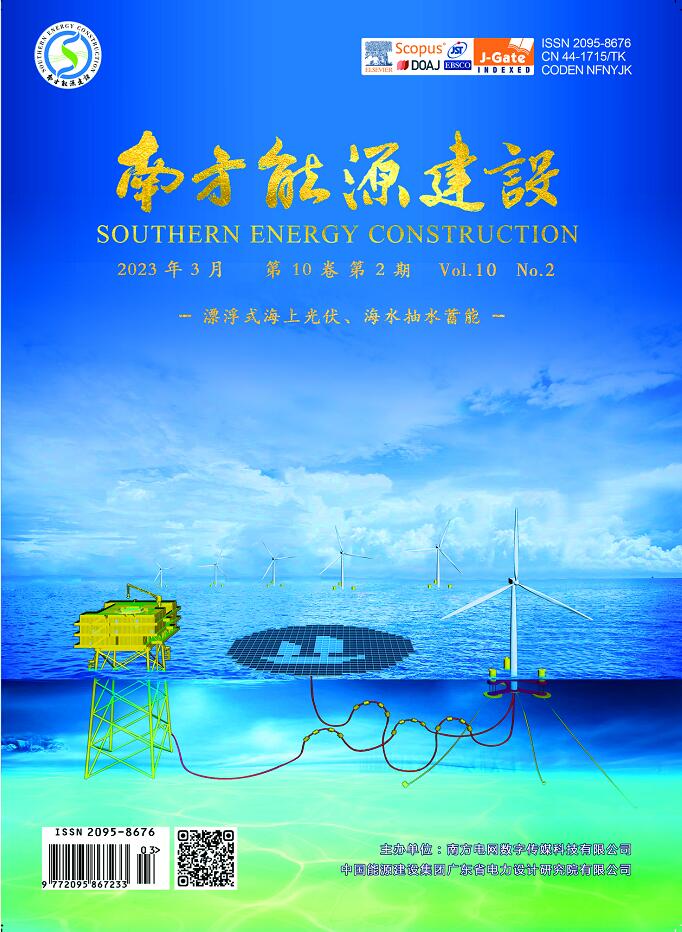

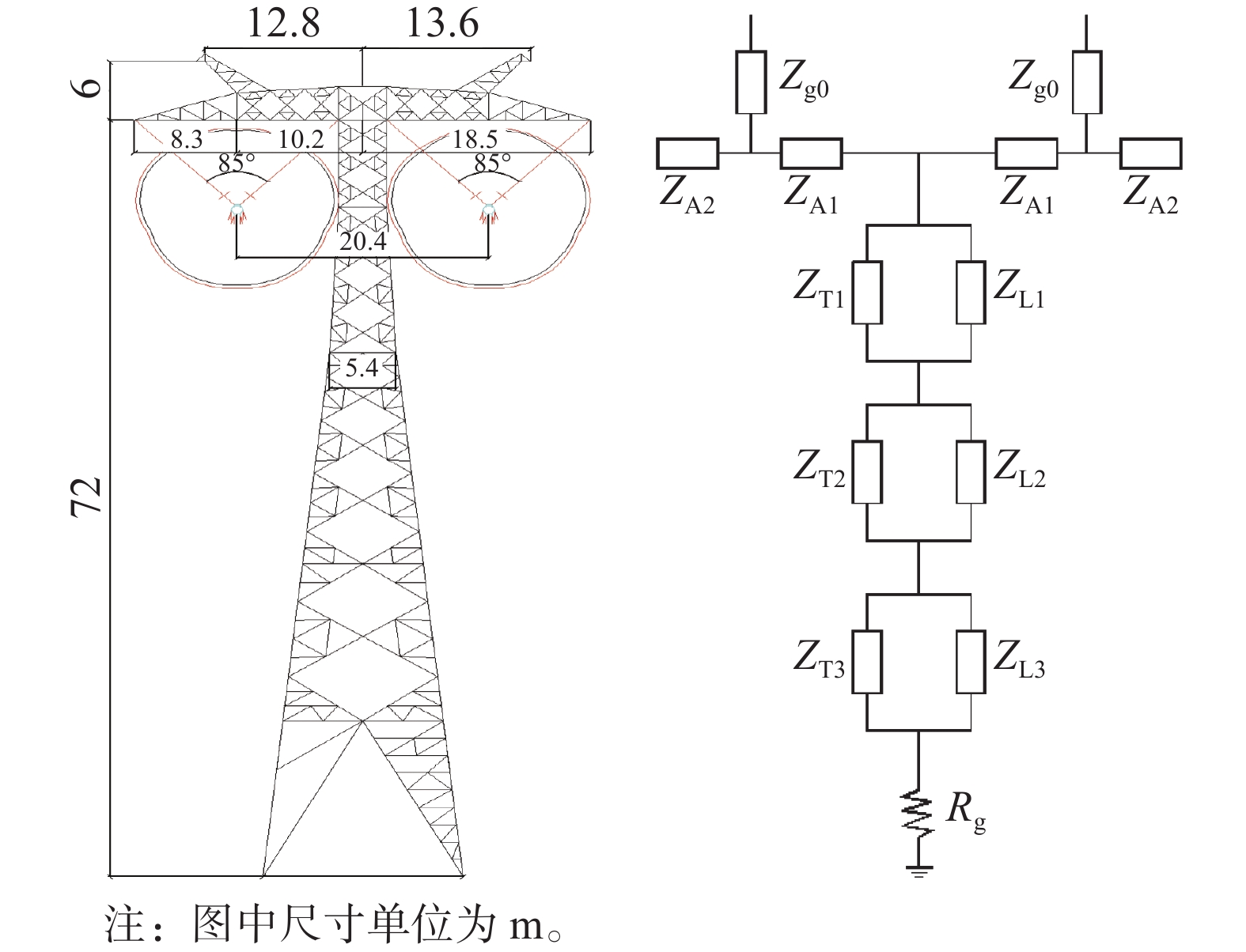


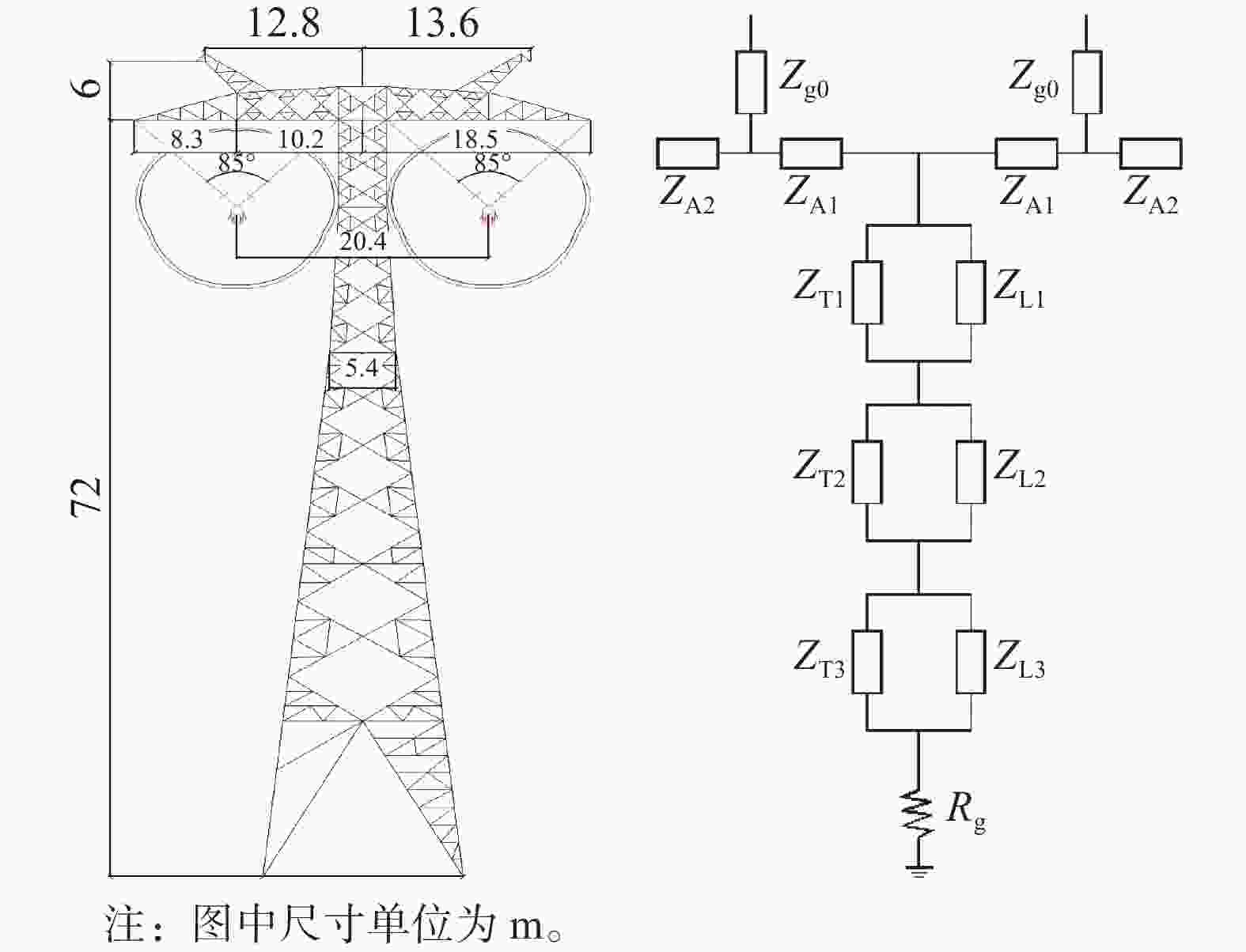
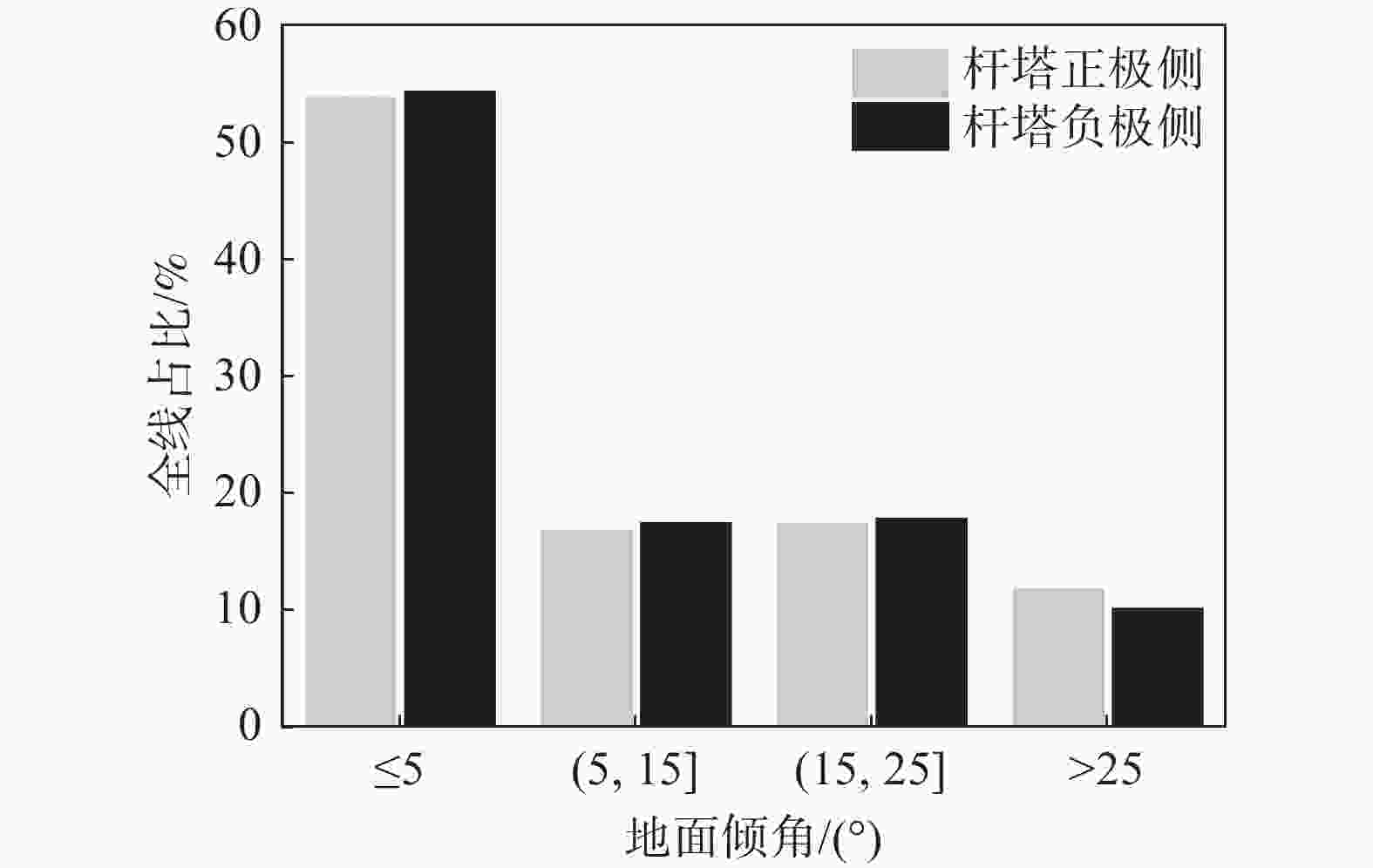
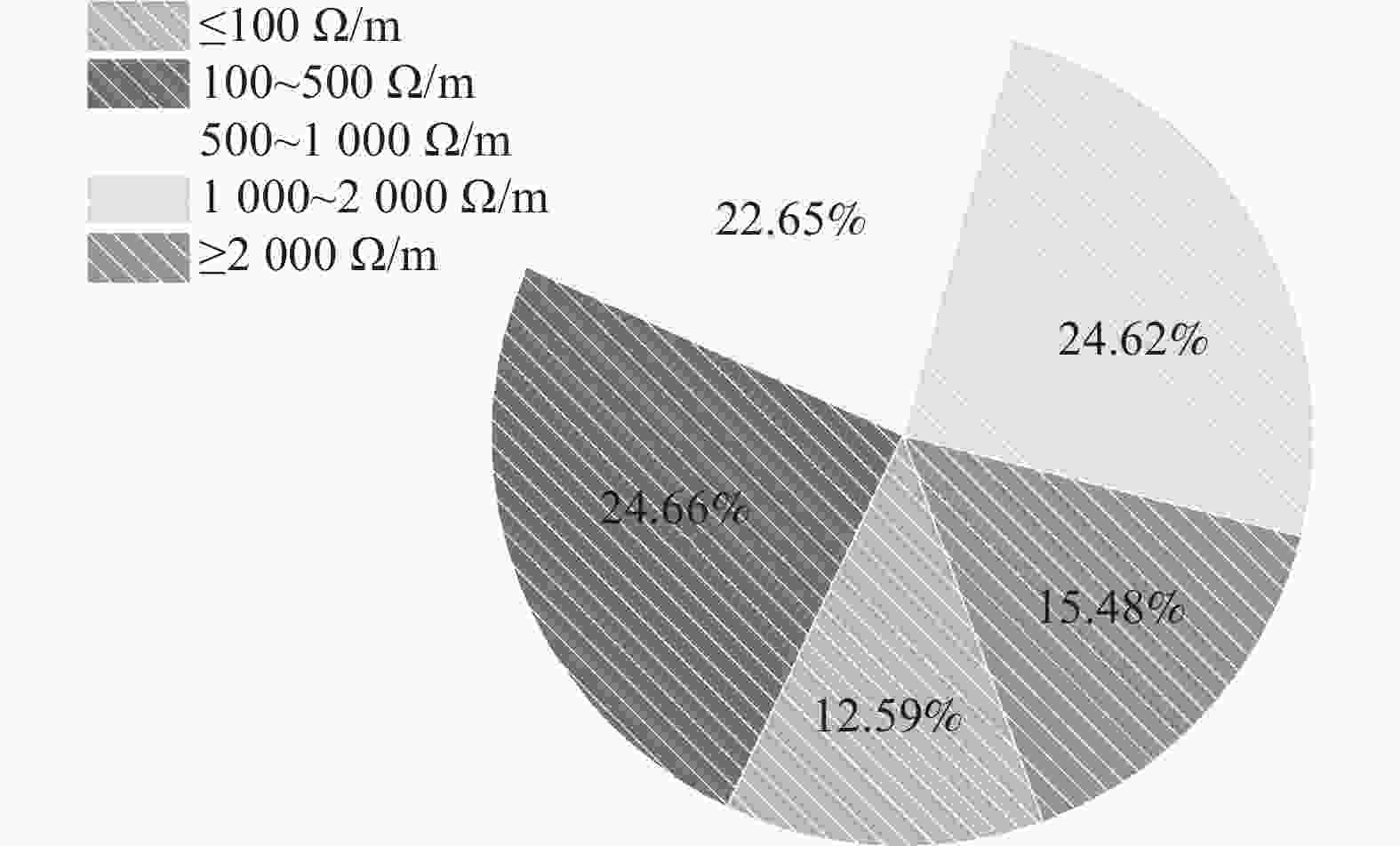






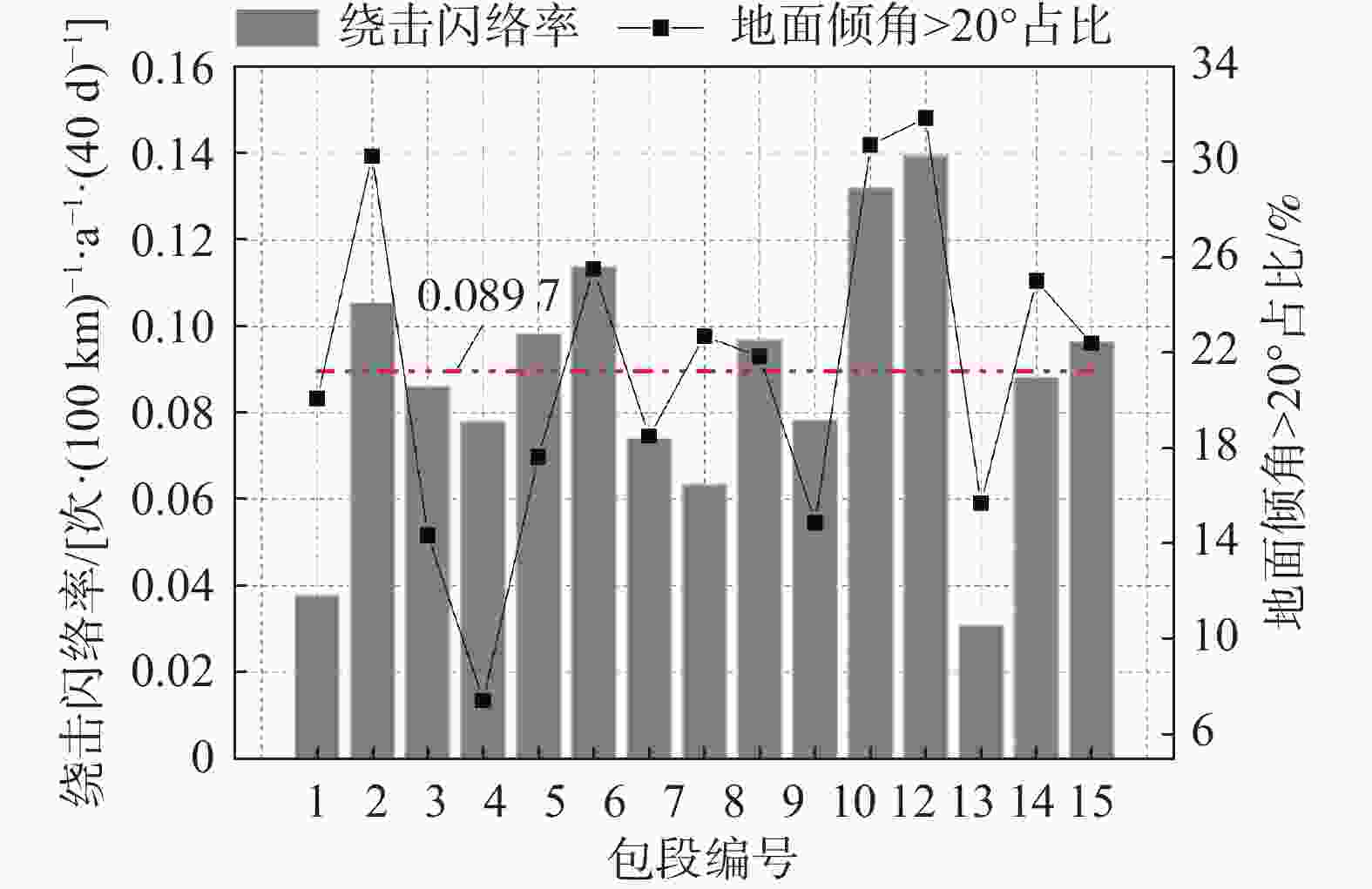

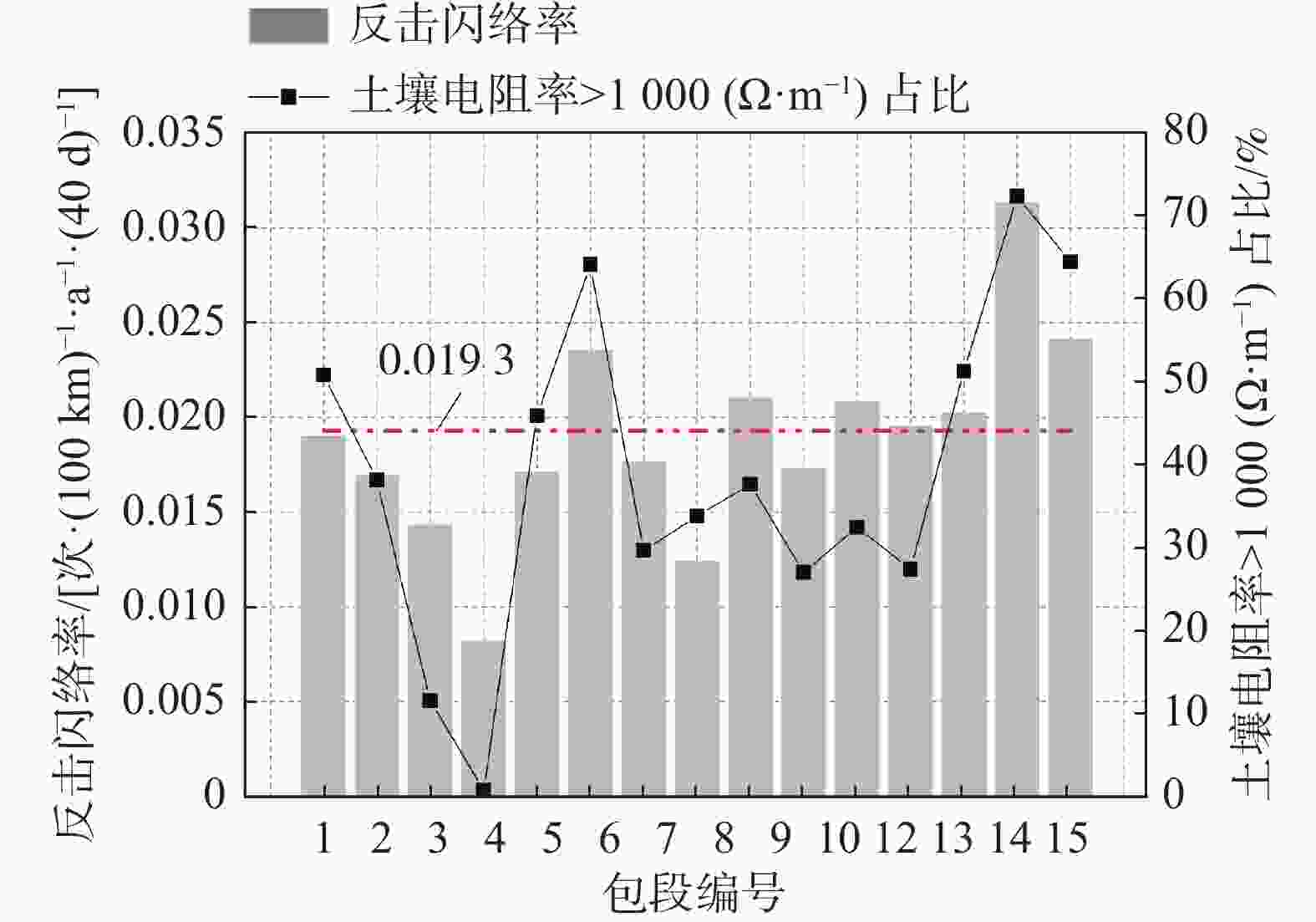




 DownLoad:
DownLoad:
